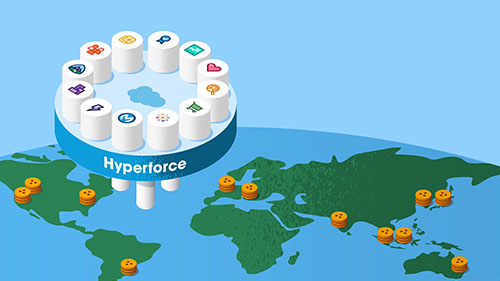Insights & Updates from the Cloudastick Team

Hyperforce is a modern approach to workforce management that utilizes technology to create a more agile and responsive workforce. It allows companies to quickly adapt to changing market conditions, customer needs, and employee preferences, while reducing costs and increasing efficiency.
Hyperforce combines digital tools and analytics to automate repetitive tasks, streamline processes, and empower employees to work more independently. This approach creates a more agile and flexible workforce that can respond quickly to changes in the business environment, such as new product launches, market fluctuations, or unforeseen events like pandemics.
The rise of digital technologies and the increasing prevalence of remote work have made it necessary for companies to rethink their workforce management strategies. Hyperforce offers a solution by creating a more agile and flexible workforce that can quickly adapt to changing market conditions.
Salesforce has introduced the Hyperforce architecture to its platform. It is a cloud-based platform that provides customers with greater flexibility, scalability, and security. With Hyperforce, Salesforce customers can choose to run their Salesforce applications on any public cloud infrastructure, such as AWS, GCP, and Microsoft Azure. This gives customers more control over their Salesforce deployment and allows them to take advantage of the benefits of their preferred cloud provider.
One of the key benefits of Hyperforce is its ability to scale quickly and easily. With Hyperforce, Salesforce customers can easily add or remove resources as needed, without the need for any manual intervention. This makes it easier for companies to handle spikes in traffic or sudden changes in demand.
Another key benefit of Hyperforce is its improved security. With Hyperforce, Salesforce has implemented a new security model that provides customers with better protection against cyber threats. This includes features such as hardware security modules (HSMs), which provide tamper-proof encryption for sensitive data, and secure enclaves, which allow customers to isolate their data and applications from other customers.
Implementing Hyperforce requires a combination of technology, data analytics, and human resources management. Companies need to invest in digital tools that can automate tasks, streamline processes, and provide real-time data on workforce performance. They also need to invest in training and development programs that can help employees adapt to new ways of working and make the most of the digital tools available to them.
To implement Hyperforce effectively, companies should adopt a data-driven approach to workforce management. This means collecting and analyzing data on employee performance, customer needs, market trends, and other relevant factors, and using this data to make informed decisions about workforce planning and management.
Creating a culture of flexibility and agility is also important in implementing Hyperforce. This means empowering employees to work more independently, allowing for remote work and flexible schedules, and creating a work environment that supports collaboration, creativity, and innovation.
In conclusion, Hyperforce is a modern approach to workforce management that combines technology and analytics to create a more agile and flexible workforce. Salesforce's introduction of the Hyperforce architecture to its platform provides customers with greater flexibility, scalability, and security. Implementing Hyperforce requires investment in technology, data analytics, and human resources management, as well as creating a culture of flexibility and agility. Hyperforce can help companies stay competitive in a constantly changing business environment.